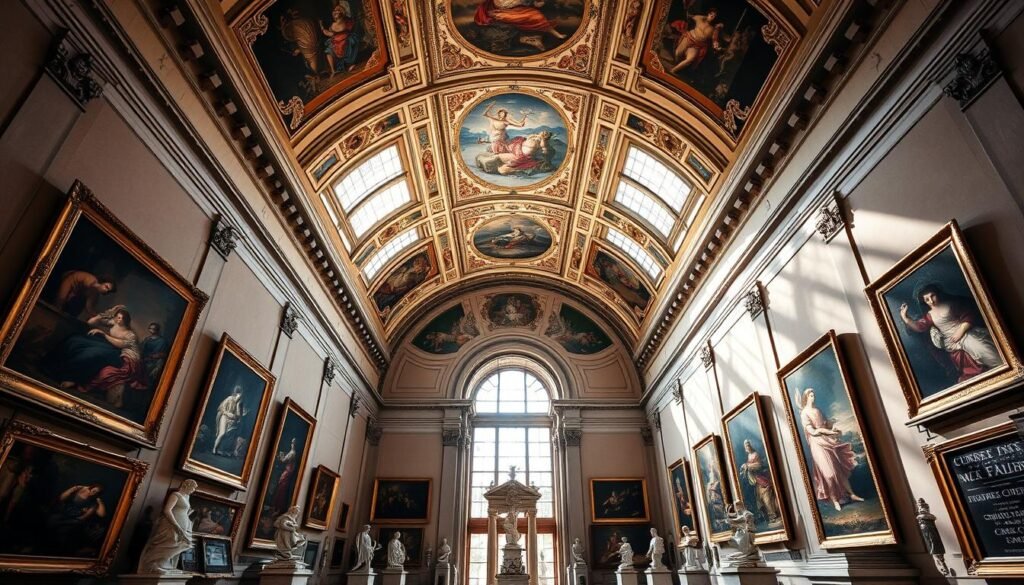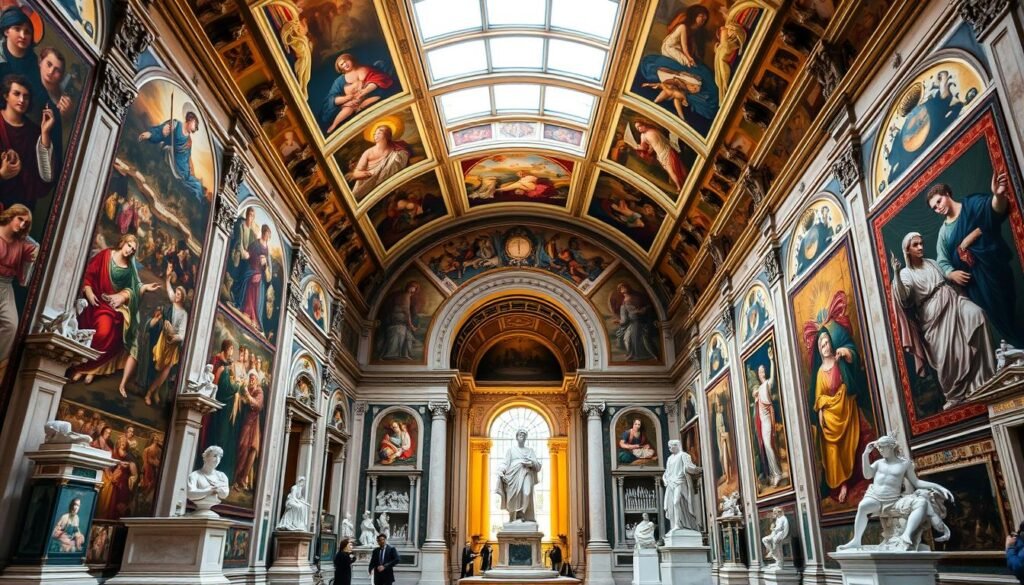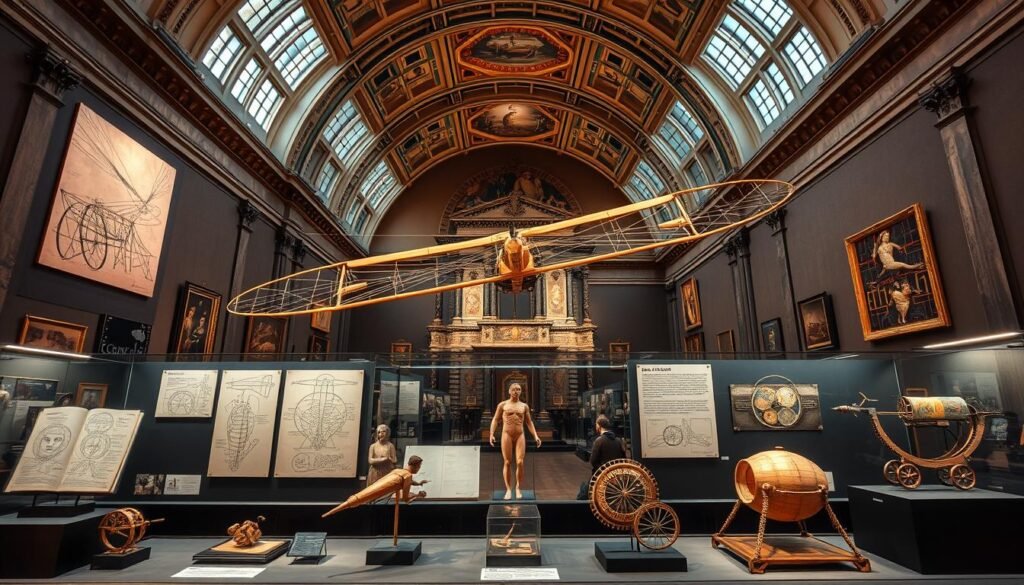Thrill of Italy | Experience Italy with authenticity.
Exploring Italy Historical Sites That Echo the Past
I feel a deep silence as I walk on hallowed grounds where history was made. My heart beats faster with every step in ancient amphitheaters, listening to whispers of conversations that once filled the air. In Italy, amid its historical sites, I sense a bond with those who came before. This country, with its rich past, is a place of beauty. It tells tales of ancient civilizations, their stories carved into each stone.
Italy’s historic places draw me in – the towering cathedrals, the old stones leading to waterways, and arenas echoing past cheers. These sites showcase human creativity and resilience. They invite us to walk the paths of history makers. Let’s explore Italy’s historical gems together. We’ll discover Italy’s soul, kept alive in its marvelous history.
Key Takeaways
- Historical attractions in Italy offer an immersive experience into the past.
- Famous historical places in Italy reflect the evolution of a nation through the arts and monuments.
- The sense of connection at Italy historical sites is palpable, blending the past with the present.
- Italy’s historical heritage is diverse, from the Circus Maximus’s ancient sportsmanship to the pinnacle of Renaissance art.
- Understanding Italy’s history through its sites enhances appreciation for the culture and the people who lived it.
- Visiting these sites isn’t just about seeing but about feeling the historical significance they embody.
Embark on a Journey to Naples's Ancient Wonders
As I plan my trip, I look forward to the Museo Archeologico Nazionale di Napoli and its amazing Pompeii exhibition. This place is key to understanding the ancient sites in Italy. The museum showcases Greco-Roman history’s treasures amidst Naples’s lively city vibe. It has everything from detailed frescoes to the ‘Secret Cabinet’ with its erotic Roman art. Each piece tells an ancient story, inviting us to listen.
The Pompeii exhibition deeply moves me. It brings back the day Pompeii was buried under ash. Walking through its streets, you feel the city’s tragic end. This reminds me how the Museo Archeologico Nazionale di Napoli connects us with history. It’s a must-visit for anyone exploring Italy’s ancient wonders.
Uncovering the Artistic Heritage of the Uffizi Gallery in Florence

As I enter the Uffizi Gallery, excitement builds with each masterpiece I see. Located in Florence, the gallery showcases human creativity at its best. It was built in 1560 by Giorgio Vasari as a U-shaped structure. It was meant to connect two palaces but now it links people to art history.
In the gallery, the room with Sandro Botticelli’s work draws me in. The painting “The Birth of Venus” captures my imagination vividly. Venus stands on a shell, symbolizing beauty. Along with “The Spring,” these paintings are central to the gallery. They show Botticelli’s skill and his inspiration from classic texts.
The Renaissance Masterpieces
The Uffizi is filled with Renaissance brilliance. Its walls tell stories spanning from the late 13th to the 21st century. You’ll find works by Giotto, Masaccio, and Piero della Francesca here. The gallery is a haven for lovers of Renaissance art. Over 250 artworks from sculptures to modern pieces are displayed on the first floor. They mark the evolution of art over the centuries.
Guided Explorations of Unmatched Beauty
A guided tour at the Uffizi makes the visit special. Guides share the deep stories behind each artwork. They convey the historical importance and the effort that went into creating these pieces. The art from various eras comes alive this way. The tour also includes a view of the Arno River and the Ponte Vecchio. This highlights the gallery’s stunning location in Florence’s heart. The Uffizi Gallery’s collection spans from the Renaissance to modern art. It reflects the Medici family’s legacy and today’s contemporary thoughts. Every visit deepens your understanding of art and the human spirit it reveals.
Capitoline Museums: A Deep Dive Into the Roman Era
![]()
Atop Rome’s Capitoline Hill, the Capitoline Museums stand as a testament to Rome’s history and art. They hold an extensive collection showcasing ancient Rome’s grandeur. Walking through the corridors, the “Capitoline Wolf” statue captures my attention. This statue is more than art; it’s a key part of Roman mythology, preserved in this historical place.
The museums are a window into the past, showing us Roman life’s details. With artifacts ranging from the “Dying Gaul” to ancient coins, they tell us about a civilization that influenced our world. Walking among these pieces, I feel moved by the stories of greatness and sometimes, sad endings.
The Capitoline Museums are guardians of Roman artifacts and their stories, including the historical ruins in Italy. Each visit teaches and inspires, connecting me with ancient architects and artisans. Being here makes the history I’ve read in books come alive, enhancing my appreciation for Roman culture and architecture.
Visiting these museums is like stepping back in time. Standing before the “Capitoline Wolf,” I feel connected to both the mythical and real Rome. This place has stood for thousands of years, its stories woven into humanity’s heart. This visit underscores the Capitoline Museums’ importance for exploring Italy’s historical ruins and ancient Roman life.
Vatican Museums: Witnessing the Catholic Legacy

I walk through the Vatican Museums, feeling the rich legacy of the Catholic Church. Each piece tells a story of religion and artistry across ages. Seeing the Sistine Chapel frescoes up close is awe-inspiring. Michelangelo’s genius draws people worldwide. They come to see the story painted on the ceiling. This place is a peak of Renaissance art, where spirituality and beauty meet.
Marvel at Michelangelo’s Sistine Chapel
The Sistine Chapel’s frescoes captivate me with their colors and emotion. They show the Vatican Museums’ impact on world culture and art.
A Tapestry of Millennia-Old Art and Faith
I explore the Vatican Museums, finding art and faith combined. This place tells the tale of a spirituality that influenced many. In each room, from the Rafael Rooms to the Gallery of Maps, I feel the Catholic Church’s calm yet strong spirit. Here, faith and art merge into a memorable journey. It invites all to ponder both what’s seen and what’s felt within.
The Genius of da Vinci: Milan's Tribute to Science and Art

My visit to the Museo Nazionale della Scienza e della Tecnologia “Leonardo da Vinci” in Milan was unforgettable. It felt like stepping into the mind of a genius. The museum showcases how Milan plays a key role in keeping our scientific history alive.The museum brings Leonardo’s inventions to life, not just through displays.
It uses interactive models and advanced technologies. This way, it highlights Leonardo’s gift of blending art and science. Visitors can truly feel the impact of his work at the Museo Nazionale della Scienza e della Tecnologia “Leonardo da Vinci”.
Exploring this site, one of the top Milan historical sites, shows the brilliance of Leonardo da Vinci. It underlines the value of keeping creativity and inquiry alive. The museum offers a special experience by making Leonardo’s ideas a reality. It acts as a hub for his legacy and continues to inspire visitors.
Architectural Marvels: Italy's Ancient Structures and Ruins
As I walk through Italy, I find stories in the stones of its old buildings. These stories make me feel connected to Italy’s rich history. This country’s ruins show not just beauty but also tell of a civilization that affects our world today.
Historical Ruins in Italy That Still Stand Tall
The Colosseum in Rome could hold 70,000 people, filled with the sounds of fighters and crowds. The Baths of Caracalla, once used by 1,600 people daily, show Rome’s community and design skills. Exploring these ruins, I learn how ancient Romans lived.
The Allure of Italy’s Rich Architectural Past
Ostia Antica was Rome’s busy port. Palatine Hill is where Rome began. These places show the ancient Romans’ planning and aesthetic talents. The Pantheon, beautiful and strong, stands tall in Rome. It’s a symbol of ancient engineering. Visiting these sites makes me appreciate ancient Roman architecture even more.
The history in this land, from the Appian Way to the Roman Forum, teaches us about past efforts. Italy’s ancient buildings are more than old relics. They’re like classrooms, silently teaching us the value of human spirit and creativity. As the day ends in Rome and shadows fall over the ruins, I remember what I’ve learned. These architectural wonders, from theaters to temples, show the power of human creativity. They remind us of what was and what still is.
Italy Historical Sites in Italy That Will Take You Back in Time

Exploring Italy’s historical sites showcases the country’s rich history. At every turn, ancient roads and majestic villas tell stories of empires and iconic leaders. This calls for history enthusiasts to explore deeper. The Appian Way is a must-visit historical site in Italy. Constructed between 312-310 BC, it linked Rome to Capua. It was crucial for military and trade. Walking this path, I felt connected to Rome’s glory days, surrounded by historical whispers.
About 15 kilometers north of modern Rome is the Villa Ad Gallinas Albas. It’s believed to be Empress Livia’s villa. The serenity here contrasts with its imperial past, offering a peek into Roman personal lives.
In ancient Tivoli, the sanctuary to Hercules Vitor, built at the end of the 2nd century BC, showcases religious and cultural depth. Across Italy, from Ostia to Hadrian’s villa, each site shares part of Italy’s historical story. Visiting the floating palaces at Lake of Nemi was like stepping into a poem. These were built under Emperor Caligula in the 2nd century BC. Imagining the grand Roman feasts and schemes here was thrilling. It shows the grandeur of that era’s architecture and way of life.
Visiting these sites, my appreciation for Italy’s history grows. Each location is vital in the grand narrative of human history. Italy keeps its history alive, offering deep connections to the past for all who visit.
Famous Historical Places in Italy and Their Timeless Stories
Traveling through Italy, one feels the history in the air. Especially at famous historical places. These sites show the country’s architectural skill and cultural stories. The stories of Italian sites are crucial to the nation’s identity. The Colosseum in Rome, for example, draws millions each year. It showcases ancient Roman society’s creativity and ambition. It also tells tales of gladiators, highlighting the valor and harshness of the time.
Legends and Myths Enlivening Italian Historical Landmarks
Places like the Roman Forum and the Spanish Steps are rich in legends. The Forum allows walks among ruins of intense political and historical events. The Spanish Steps, come spring, bloom with azaleas. They echo stories of poets and artists who found inspiration there.
The Personalities Behind Italy’s Monumental Sites
Important figures have shaped Italy’s iconic sites. St. Peter’s Square is more than an architectural marvel by Gian Lorenzo Bernini. It’s a place where many feel connected to Vatican City’s spiritual and historical significance. The Pantheon, with its impressive dome, shows engineering genius. It tells of Rome’s religious evolution, from paganism to Christianity, reflecting various emperors’ influences. Exploring the stories behind these Italian sites deepens the appreciation for Italy’s history. It’s more than dates; it’s a colorful tapestry in the streets and stones. Each visit and story draws one closer to Italy’s true magic.
Preserving the Past: Conservation Efforts of Italian Historical Sites
For those eager to explore beyond Rome and Venice, Italy has much to offer. Hidden gems filled with history are scattered across the country. These places are home to museums and sites telling stories of historical splendor and cultural progress.
Discovering Italy’s Lesser-Known Historical Attractions
The Museo Archeologico Nazionale di Taranto is one such treasure. It’s in southern Italy, offering a glimpse into the richness of ancient Magna Graecia. With its collection of Greek and Roman artifacts, the museum takes visitors on a journey. This journey shows how conquest, culture, and art have shaped the area.
In Rome, the Museo Nazionale di Palazzo Venezia reveals a different narrative. Located in a historical palace, it covers periods from the Medieval to the Renaissance. The museum provides an artistic voyage through Italy’s key historic phases, all within a building that has seen many historical moments.
Secret Stories of Italian Heritage Sites
Exploring these sites is like unraveling the layers of time. Every artifact and column tells of a time when these places were central to Italy. The gardens, cared for over the years, whisper of the past. The beauty of these sites is matched by the untold stories they keep. These are stories of daily life, now forever part of history.
Exploring places like the Museo Archeologico Nazionale di Taranto and the Museo Nazionale di Palazzo Venezia deepens our understanding of Italy. This journey enriches our experience far beyond the usual tourist routes.
Italy’s Tapestry of History: From Ancient Empires to the Renaissance
In Italy, every view blends Italy’s rich history with the present. It’s a journey from ancient empires to the Renaissance. It’s where the past of the Samnites and Etruscans meets the genius of the Renaissance. In Padova, history surrounds you. Prato della Valle is more than a large space. It’s a place where history lives on.
The University of Padova, since 1222, shows the city’s long academic tradition and Italian cultural heritage. Every corner of Padova has a story. The Orto Botanico di Padova is a serene spot with a history. Since 1545, it has nurtured over 7,000 plant species. This garden is a tribute to plant evolution and Italy’s dedication to conservation.
The Basilica di Sant’Antonio offers spiritual peace. It attracts people from across the world. The Scrovegni Chapel, featuring Giotto’s frescoes, showcases Italy’s rich art history. Both add profound layers to Italy’s historical narrative. Italy is more than a country; it’s a living history lesson. Its cultural threads weave a story of human progress. This makes me eager to keep coming back, to discover and learn more.
Walking through Italy’s legendary sites, the success of their conservation becomes obvious. The rich history in cities like Florence and Lucca shows Italy’s dedication to saving its cultural sites. These places stand the test of time because of it.
Consider the Florence flood of 1966 and its aftermath.
Experts restored artworks with techniques that ensure their future. Italy has many such projects to protect its treasures from harm, keeping our global heritage safe. I helped in a project in Cinque Terre, working on ancient vineyards. These vineyards are over a thousand years old. Our work helped save this agricultural gem and protect it from environmental threats, blending old ways with new needs.
I’m moved by the stories of those working to preserve Italy’s history. Their efforts to keep Italy’s buildings and culture safe inspire people around the world. They make sure Italy’s stories will reach the next generations. Efforts to save Italy’s historical sites show a deep care for our cultural roots. Italy’s rich history, captured in buildings and tales, thrives because of these efforts. This work keeps the legacy of Italy’s ancestors vibrant and accessible to all.
Exploring Italy’s Historical Museums for an Immersive Experience
My journey through Italy’s historical museums connects me deeply to its glorious past. These halls, filled with centuries of history, immerse me in Italy’s story. I find myself in the nation’s narrative.
Mingle With the Artifacts of A Bygone Era
Visiting Italy’s museums feels like a step back in time. At the Naples Archaeological Museum, I’m amazed by stories from when Vesuvius erupted. These places bring ancient worlds back to life.
The artifacts whisper tales from the past. They let me walk alongside history’s makers, bringing their stories to life.
Museums Capturing the Essence of Italy’s Glorious Past
The museums hold Italy’s story, from Renaissance art to Ravenna’s mosaics. Each piece offers me an immersive historical experience in Italy. Time’s tales become real and touching. I travel through time in these museums. They’re not just buildings but gateways to understanding Italy. They blend history with reality, making every visit enlightening and moving. Rome’s ancient wonders and the Renaissance’s art show Italy’s grandeur. The variety in collections showcases Italian heritage’s richness. My visits are more than just tours; they’re lively history encounters. They drive me to keep exploring Italy’s historical museums.
Italy's Rich History Reflected in Every Stone and Fresco
As I travel through Italy, every city tells its own story. The history of Italy is captured in the stones of Torino and the frescoes in Florence. Torino, home to nearly 850,000 people, is Italy’s fourth-largest city. It became the first capital after Italy united in 1861.
The city’s grand porticoes stretch for 18 kilometers, with 12.4 kilometers bustling with the sounds of history. At the archaeological park of Ostia Antica, amazement fills me. This park covers 150 hectares, making it one of Europe’s largest. Though only 40% has been excavated, it feels like stepping back in time.
The park was home to 60,000 people in the 2nd and 3rd centuries AD. It features a large theater and advanced Roman toilets, showing a thriving ancient community.
My adventure continues with an 11-day tour that dives deep into Italy’s historic sites. The package costs $5549, including flights from New York, or $4849 without. Designed for just 16 people, it offers an intimate exploration of Italy’s rich history and culture. We will visit Venice, Siena, Tuscany, and the cliffs of Capri and Anacapri. Each location is a new chapter in Italy’s grand narrative. My soul is touched by Italy’s eternal legacy, told in stone and frescoes.
